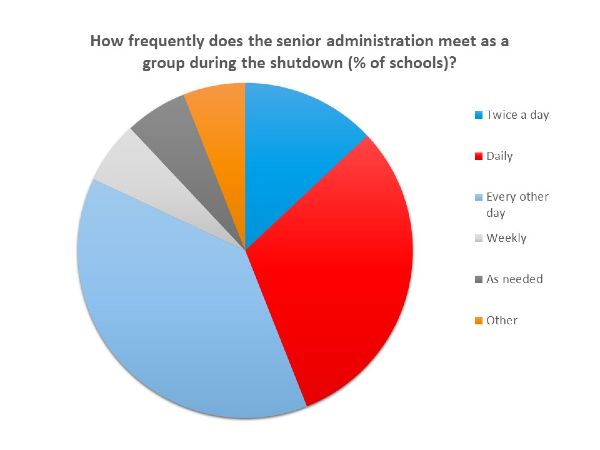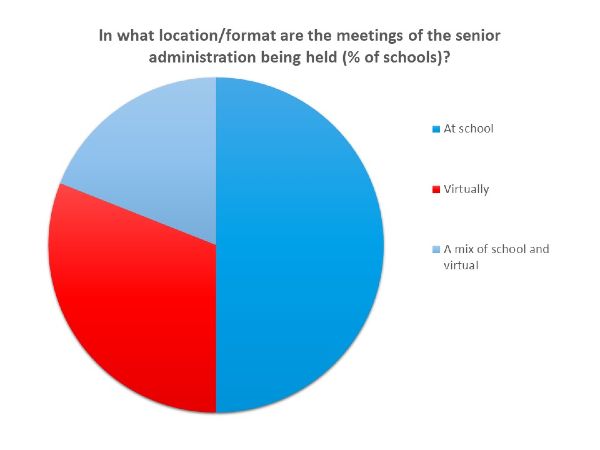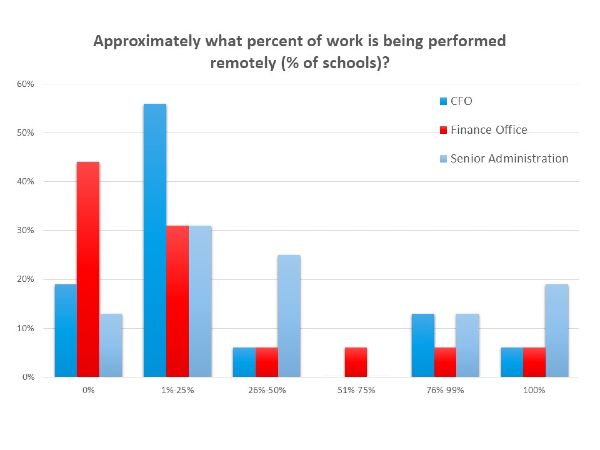The information below was accurate as of press time. However, as the situation surrounding COVID-19 has evolved, some data have changed since publication. Additionally, this information is provided for general educational purposes only. It should not be relied upon as, or in place of, legal or other professional advice. Readers are encouraged to stay informed through news and recommendations for their own communities and also work with their schools’ trusted counsel and partners when addressing specific issues.
By Amber Stockham
With thirty three states and many more localities mandating the closure of schools for at least a two week period, many independent schools that had intended to remain open are convening their administrative teams to shift their strategy and determine the best path forward.
Guidance for academic continuity through remote learning and online classrooms has been provided by NAIS, One Schoolhouse, Global Online Academy, and Stanford Online High School. NBOA previously published a case study detailing how Western Academy Beijing launched its online learning program in the wake of China’s mandatory school closures. Many schools have considered the potential need for remote learning options in the wake of natural disasters, and some are finding that their forethought and preparation are leading to a relatively smooth transition, while others are finding their efforts hampered by economic concerns or unforeseen technology issues.
Guidance for continuation of business operations for schools, however, has been less forthcoming and is often issued from the perspective of insurers or attorneys. As the federal government debates emergency support for businesses, schools are facing the unprecedented task of moving not just learning but all operations to a virtual platform while working to maintain a safe work environment for those whose work cannot move online. NBOA has provided previous guidance related to business operations during an outbreak, and we are updating that guidance here to focus on the needs of schools that have closed their campuses.
Communications
Whether you are continuing education online or temporarily suspending your program, schools will need to draft two communications: one for students and families, and one for faculty and staff.
Communications to families should provide as much information about the current situation as possible and should include an expectation of when another update will be provided. Students and families will need to know how the school plans to fulfill its mission and deliver the quality education and experience families have come to expect from the school. For schools that are continuing education online, include expectations for the students’ academic commitments and the family’s support of those commitments. List necessary equipment and supplies as well as contact information for families that have concerns about their ability to support remote learning.
Communications with faculty and staff should include similar expectations.
- Indicate an anticipated time frame for the campus closure and the school’s current intentions for both short-term and long-term operations.
- Clarify how employees should engage with the school in the coming weeks.
- Provide expectations for upcoming events that may be cancelled or hosted virtually. All necessary meetings should be moved to a teleconference or virtual space.
- Communicate with employees individually about their status: if they will be moved to telework, asked to continue to report to campus, or if they will be furloughed.
- Clarify if and how they will be paid.
- For employees who are not working, set expectations to remain in contact by periodically checking email or verbally checking with their supervisor. Note that hourly employees must be paid for all work performed, including checking their emails.
Remain in contact with updates on the status of the school’s operations and guidance for community members’ safety and security. Fact-driven and non-alarmist communications will help to reassure the community that the school is taking considered steps during this crisis. Write messages in easily comprehensible language and translate them into all languages spoken by the community. Be as transparent as possible while reserving the flexibility needed for the school to alter its plans as the situation evolves.
Carefully consider which means of communication are utilized at this time and in what circumstances, taking advantage of digital platforms, verbal and written communications, and emergency communications systems when appropriate in order to provide consistent communications while assuring the community that the school is committed to its mission and values.
Illness
All schools continuing operations in any way should consider the impact of potential illnesses upon those operations. Schools that have initiated distance learning or that intend to re-open their campuses after a short suspension of operations should plan for the impact of student illness upon their classwork. Establish and communicate early on expectations for students who may fall behind due to illness.
Likewise establish and communicate expectations for faculty and staff who fall ill or who become caregivers for ill family members. The following steps may help mitigate potential impacts to operations:
- Reiterate and distribute in writing the protocols for communicating illness-related absences to the school. This is also a good time to remind all employees how much, if any, time off they have available.
- Ensure all class syllabi are current, and store comprehensive lesson plans in an accessible space in case responsibility for the class falls to a different teacher.
- Clearly document all essential operations that are performed by only one or two people and if possible, cross-train other employees in the department on these functions.
Schools should be aware that employees who fall ill or who have ill family members may be entitled to protections under the Family Medical Leave Act, the Americans with Disabilities Act, and any state or local leave laws. Employees such as nurses and dorm parents who may be exposed to COVID-19 and become ill from it due to the nature of their jobs also may be eligible for worker’s compensation. Anytime an employee becomes seriously ill, it is best practice to immediately notify human resources and/or school counsel and ascertain what protections, if any, are applicable to the employee’s situation.
Telework
Consider practical limitations and concerns when asking faculty and staff to work from home. Many people will be working from home for the first time, and they may find it to be unexpectedly challenging.
Any employee being asked to work from home must be supplied with the appropriate technology to do so. Technological considerations may include a laptop, camera, telephone, printer or scanner, and any other specialized equipment the employee uses to complete their job. Access to high speed internet may be a concern in some areas.
Speak with employees who will be working from home to ensure the environment is conducive to their work. Will the employee have a dedicated workspace? Provide expectations for employees’ working hours and anticipated productivity. For some positions, this will vary with the transition to remote work, and expectations should be conveyed clearly prior to the move. Have honest conversations about home dynamics and an employee’s anticipated household responsibilities during the work day, particularly if children may be home due to school closures.
Working from home for the first time can be very stressful. Consider potential support systems the school can activate for employees who find the change challenging. These can include regular video chats with supervisors or colleagues, virtual bulletin boards, or increased engagement with the school through standard communication channels. If your school offers stress support services through employee assistance programs, wellness programs, or health insurers, remind employees that these options can be engaged if they are needed.
Payroll
Financial issues are top of mind for schools, and few are as impactful as payroll. A federal emergency response bill may contain provisions for paid sick leave and potential payroll tax waivers for employees. This is in direct response to the vulnerable situation in which many low-income workers find themselves, as their jobs are suspended during this crisis.
In the meantime, schools are struggling with when and how to pay employees and how best to support all faculty and staff during times of closure. Some schools have opted to pay all employees during closure, regardless of their work status. Others have opted to pay only those who are still working and full-time employees who are furloughed. Each school will make this decision based upon its mission, values and financial capabilities.
Review the employee handbook and all payroll-related policies when developing a plan for the payment of employees during closure. Any plan should be at least as generous as the written policies stipulate. Unless otherwise mandated by state or local law, federal law states schools then have the following options:
Salaried exempt employees are those who are paid on a salary basis and who do not receive overtime pay when they work more than 40 hours in a week. These workers are not eligible for overtime pay, but in return, circumstances under which their wages can be docked are limited.
- Exempt employees who are ready and able to work but for whom work is not available must be paid their full weekly wage for any week in which they have worked.
- If an exempt employee becomes sick and the school does not provide paid sick leave to employees, the exempt employee must be paid their full weekly wage for any week in which they have worked.
- If exempt employees are eligible for paid leave, they can be asked to use it for any scheduled full or half days in which they do not work. When exempt employees have exhausted their paid time off or must take a personal day when they are not eligible for paid time off, their wage can be docked in full day increments only.
Hourly employees must be paid for all hours they work, but they are not required to be paid for non-working hours.
- Schools can ask hourly employees who are scheduled to work and who call out sick to use any paid time off they have available to them.
- Schools can also offer to pay furloughed hourly employees their regular wage, but this is not necessary under federal law.
- If employees have paid time off available to them, schools should allow them to use it during furloughs but cannot force them to use it unless work was available to the employee and it was declined.
- Under federal law, schools are not required to allow employees to use paid sick time for non-working time in which they were not ill. However, schools should be aware that many states and localities extend extra protections to employees, and they should consider any applicable laws when making decisions related to payroll.
Contracted faculty may have additional wage protections based upon language in their contracts.
- Contracts which do not allow for changes or cancellation based upon force majeure or other unforeseeable changes to enrollment or operations may need to be paid in full, even if the employee is not working.
- Schools should carefully read their employee contracts, follow the language in current contracts and make changes to next year’s contracts if they are deemed to be unsupportive of the school’s need to respond to unforeseen circumstances.
Employees whose wages are being cut or who are being furloughed may be eligible for unemployment payments.
- If large numbers of employees are being furloughed, the school should consult its school counsel, because laws regulating mass layoffs may be triggered. Schools will need to consider the potential financial implications of unpaid furloughs, particularly schools that may trigger mass layoff severance protections or those that pay unemployment dollar-for-dollar as well as the potential damage to the school’s reputation.
- Any wages the school pays for hours not worked may be considered severance pay should the school fail to re-open when scheduled, and this can affect future payments owed to employees who do not return to the school.
Facilities
It is unlikely that schools will be able to close their campuses entirely. Despite the departure of students, facilities must be secured, deliveries accepted and basic maintenance provided. Consider how campus closures will affect these operations.
Because some employees will remain on campus, enhanced sanitization procedures should continue to be utilized. It should be noted that at this time, there is no evidence that COVID-19 is transmissible through environment exposures including contact with contaminated surfaces or aerosolization. However, there is evidence that the virus can live for extended periods of time on hard surfaces, and all frequently touched surfaces should be disinfected regularly as a precautionary measure. The CDC has issued guidance for properly sanitizing facilities. The EPA has released a list of approved disinfectants for use against SARS-CoV-2, the virus which causes COVID-19, and schools should confirm that their disinfectants are on the list. Those who are cleaning these spaces should be provided with appropriate personal protective equipment and instructed in its use. ISSA has issued guidance as to when equipment is necessary and the proper usage of equipment.
Ask employees who remain on campus to practice good hygiene, washing their hands regularly for at least 20 seconds with soap and water, and utilizing hand sanitizer when hand washing is impractical. Provide hand sanitizer in all occupied public spaces. Social distancing practices should also be maintained with employees refraining from physical contact with other personnel, utilizing electronic communications when possible and staggering shifts to limit interpersonal contact.
Schools with residential personnel may find those personnel are unable to leave campus. In these circumstances, schools should consider what basic services will be provided to residents, likely including security, facilities maintenance and mail delivery. Schools that regularly supply residents with dining services or health services should consider discontinuing these practices during closure if at all possible.
Limit members of the outside community to campus. Property owners have a duty to protect both residents and visitors from hazards which are not open and obvious, including communicable diseases, and schools could be liable for damages related to negligence if they fail to respond appropriately to the threat presented by COVID-19 and limit access to the campus.
- Review any facilities rental contracts which are still active and cancel these services if possible.
- Third party vendors that operate on campus in auxiliary services and delivery personnel are a regular fixture of school life. Determine what vendors are regularly present on campus and notify them if their services will not be needed during campus closure. Contracts with these vendors may indicate penalties for suspension of services, so review these contracts prior to making any decisions. Vendors whose services are needed should be notified of safety and hygiene procedures that will be required of their personnel when on campus. Ask these vendors what they are doing to protect their personnel and/or address the threat posed by COVID-19.
-








